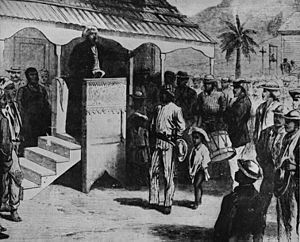Samaná Americans facts for kids

The Samaná Americans (called Americanos de Samaná in Spanish) are a special group of people living in the Samaná Province of the Dominican Republic. They are descendants of African Americans who moved there a long time ago.
How the Samaná Americans Started
Most Samaná Americans are descendants of African Americans who moved to the island of Hispaniola starting in 1824. At that time, the island was under the control of Haiti. The Haitian president, Jean-Pierre Boyer, helped make it easier for these people to move there.
A man named Jonathas Granville traveled to the United States in 1824. He met with people who wanted to end slavery, called abolitionists. These included Richard Allen, Samuel Cornish, and Benjamin Lundy. They worked together to encourage African Americans to move to Haiti. This movement was called the Haitian emigration.
More than 6,000 people moved to Hispaniola in less than a year. However, many faced problems and later returned to the U.S. But many others stayed. By 1871, when Frederick Douglass visited, there were clear communities of these settlers in places like Puerto Plata and Santo Domingo.
The most unique and lasting community was in Samaná. This group has kept its special culture until today. They call themselves Samaná Americans and are known by other Dominicans as los americanos de Samaná. Some members of this community still speak a special kind of English called Samaná English.
What Makes Them Unique
The Samaná Americans have kept many parts of 19th-century African American culture. These include their unique Samaná English language, their traditional foods, games, and community groups. Many of these traditions have actually disappeared in the United States.
Over time, they have also shared some culture with other groups in Samaná, like Haitian communities and the Spanish-speaking majority. But for most of their history, the English-speaking community stayed mostly to themselves. They often married within their own group or with other Black immigrant groups who were also Protestant and English-speaking, like the cocolos.
This was partly because the Samaná community was quite isolated. Until the 1900s, you could only reach them by boat, as there were no roads connecting them to the rest of the island. Most Samaná Americans follow the African Methodist Episcopal and Wesleyan religions, which their ancestors brought with them.
Today's Samaná Americans
It's hard to know exactly how many Samaná Americans there are today. This is because some marry outside the group, and some move away from the peninsula. In the past, about 8,000 people were estimated to speak Samaná English.
However, this number has gone down a lot. Researchers find it hard to find Samaná English speakers, even among older people. No one speaks only English anymore; all Samaná Americans who speak English also speak Spanish. Because of the strong influence of the main Dominican culture, including Spanish-language schools, many parts of their unique culture are slowly fading.

